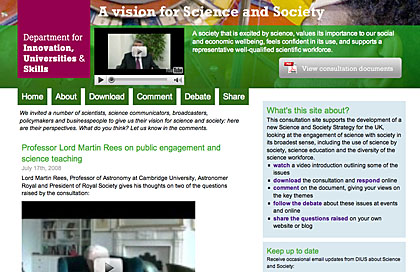Some consultations are basically dull. Some are politically-charged. Some are hurried. So when the Science and Society consultation came sauntering along, it was clear this was an opportunity too good to miss. It’s a genuine call for ideas, casting the net wide to improve the way that science is communicated, understood, taught, and recruited for. What can we do to improve trust and confidence in scientists? How can we get more high quality science broadcasting and more intelligent media coverage of science issues? How can science be taught in school in more engaging ways? Interesting stuff.
These issues are ripe for a more interactive, distributed approach enabled by social media – a truly ‘social consultation’ – where the issues are conveyed in an engaging way and people can respond in whole or in part through a number of channels, whether in our space or theirs.
Inspired by the truly groundbreaking Governance of Britain site that Puffbox developed for Ministry of Justice, we pitched the idea of a ‘hub’ site to the policy team, as a focus for the debate online and a technology solution to the challenge of harnessing the activities of stakeholders in a manageable way.
Like most consultations, the full document runs to 50+ pages with 34 meaty questions. Whilst virtually everyone has an interest in some of the issues, virtually nobody is interested in all of them. So our big experiment with this project is the idea of ‘widgetising’ the consultation questions so that bloggers or website owners can easily host a debate about the few issues which interest them and their network.
Complementing this is some truly remarkable content. My phenomenal new colleague Georgia – originally in the office for a week’s work experience – stayed on for more, organising the interviewing and filming of ten eminent scientists, broadcasters and policymakers you can watch on the site talking about the consultation. We’ll be aiming to keep the blog area fresh with these personal perspectives over the summer.
There’s the second outing of a CommentPress-powered ‘commentable’ version of a document, allowing visitors to leave public comments on specific questions or paragraphs. It’s not a panacea though: the CommentPress theme out-of-the-box needs a bit of work to make it robust and accessible, and we’re hoping to smooth some of the rough edges over the next few weeks.
Tracking the wider online debate is where we’ve borrowed most liberally from the excellent work of others: bringing in Parliamentary mentions from TheyWorkForYou as originally demonstrated by TellThemWhatYouThink; a Deli.cio.us account to publicly share links on the site as pioneered by Governance of Britain; and an internally-focussed Netvibes-based dashboard to help officials keep track of online coverage.
A bit of a kitchen-sink approach? Maybe, but we’ve tried to apply some strategy to our choices:
– Yes to a Facebook group (we’ll be running events later and want to widen our network)
– No to liveblogging or streaming the launch (it was a fun event, but the online audience would be too small and frankly we’ve got more engaging content)
– Yes to Twitter, but owned by Rhys – our dynamic, hip-to-the-Flickr Press Officer – and explictly corporate, science-oriented, and low volume
– No to forums: with a comment-enabled blog, CommentPress document, widgets and Del.icio.us roll we think we’ve got more applied channels for feedback
As a result of all this, I’ve spent a lot more time in the guts of WordPress than I had done before, and it’s been a positive experience virtually all the way. Believe the hype – there’s much more to it than a blogging platform – especially when teamed with the excellent SimplePie for RSS. Creating a theme from scratch is easier than it seems, honest. We’ll put the code we’ve developed into Google Code’s repository after the project in case others can benefit from it.
With so many virtual plates spinning, we’ve undoubtedly made mistakes and missed some tricks – please do help me out by showing us where the holes are.


